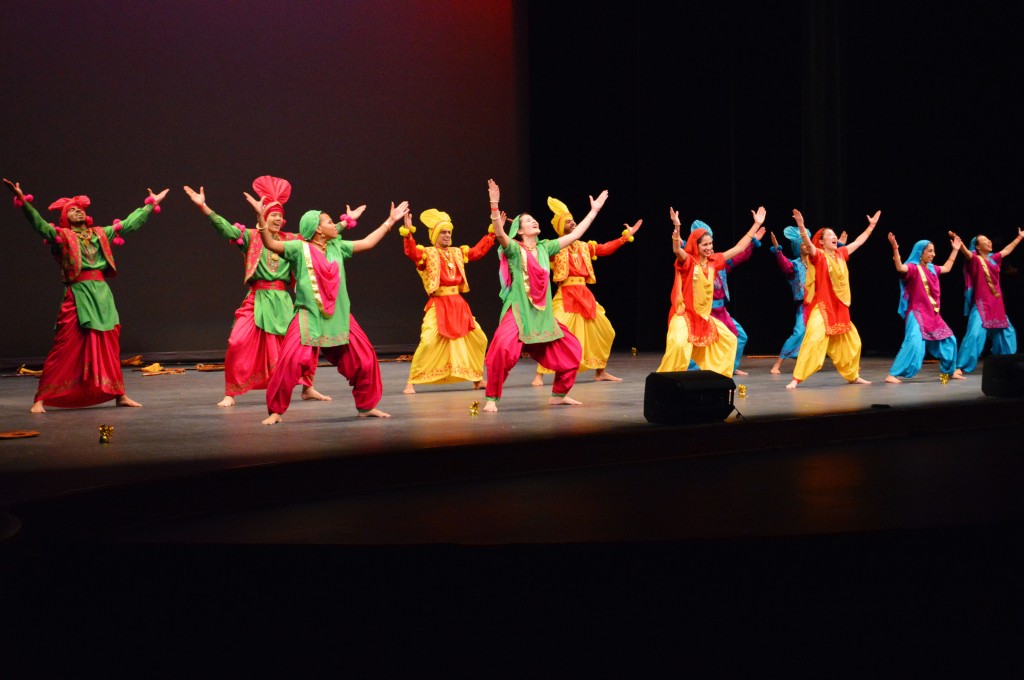
The audience cheered as Binghamton Bhangra took the stage. The competition was over, but the host performers were just warming up. As the members stood motionless in their starting positions, the music began, and members of the team, led by captain Kevin Acker, completed their energized routine as the crowd urged them on.
Binghamton Bhangra hosted its sixth-annual Bhangra Fever competition this Saturday, drawing a crowd of nearly 600 Binghamton University students as well as teams from across the country to the Osterhout Concert Theater.
Bhangra is a traditional folk dance and music genre that draws its origins from the Indian state of Punjab; it’s characterized by high energy, colorful attire and props. At Bhangra Fever Saturday, teams set themselves apart by using flags, colorful backgrounds and even the shadows of their own silhouettes to stand out.
Representatives from Carnegie Mellon University, who earned second place, made the judges take notice when three female members went on the shoulders of other male members and then leaned far back while their counterparts below spun them in a circle, creating a flower pattern with their bodies.
Eight professional and collegiate teams from states around the country, including Texas, Florida, Michigan and Pennsylvania, came to showcase their moves and compete for a first-place prize of $1,200. Binghamton Bhangra did not compete due to the potential bias from hosting but performed as the final act of the night.
Reeda Saleem, captain of Shaan Mutiyaaran Di, an all-female team of college graduates from New York City, said her team had put a lot of effort into their performance.
“We have been preparing for this competition since about August of last year and we have a brand new routine this year,” Saleem said.
Binghamton Bhangra chose the competing teams from the audition tapes of those who registered for the competition. They were judged in categories such as traditional elements, costumes and props and for technical elements like synchrony and team energy.
Kirin Kaur, secretary of Binghamton Bhangra and a sophomore majoring in integrative neuroscience, said the event took a lot of preparation due to its expansion in recent years.
“We’ve been planning this event since last November,” Kaur said. “It’s just gotten more popular and it’s expanded a lot. The biggest reason we do this though is to spread the culture and show people what Indian Punjabi culture is all about.”
Audience members were also brought to the stage throughout the night to get involved in the performances. During the night, the emcee called upon any couples who wanted to learn Bhangra to come up and join him backstage for lessons. They later showed off their moves to the audience.
“I enjoyed how interactive the event was and the energy from all the teams was amazing,” said Stephanie Wayte, a junior majoring in English. “It really made the audience want to jump on stage and join them; everyone was dancing along in their seats. The event also really showed how Bhangra is a great way to get students and people from all different backgrounds to come together and just do something they love.”
At the end of the night, Saleem said she was ecstatic when she heard her team, which took third place last year at Bhangra Fever 5, had won the grand prize. Second place went to Carnegie Mellon University’s Bhangra team, and Alamo City Bhangra from San Antonio took third.
“You never know what’s going to happen, but you put in so much work, and being rewarded for your hard work is like a feeling you can’t explain,” Saleem said. “I think the common idea I try to instill in our team is one where we don’t come in with expectations. We just go out there and do our best.”


